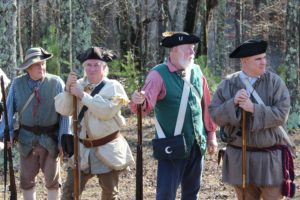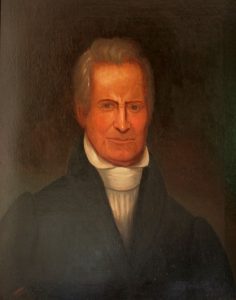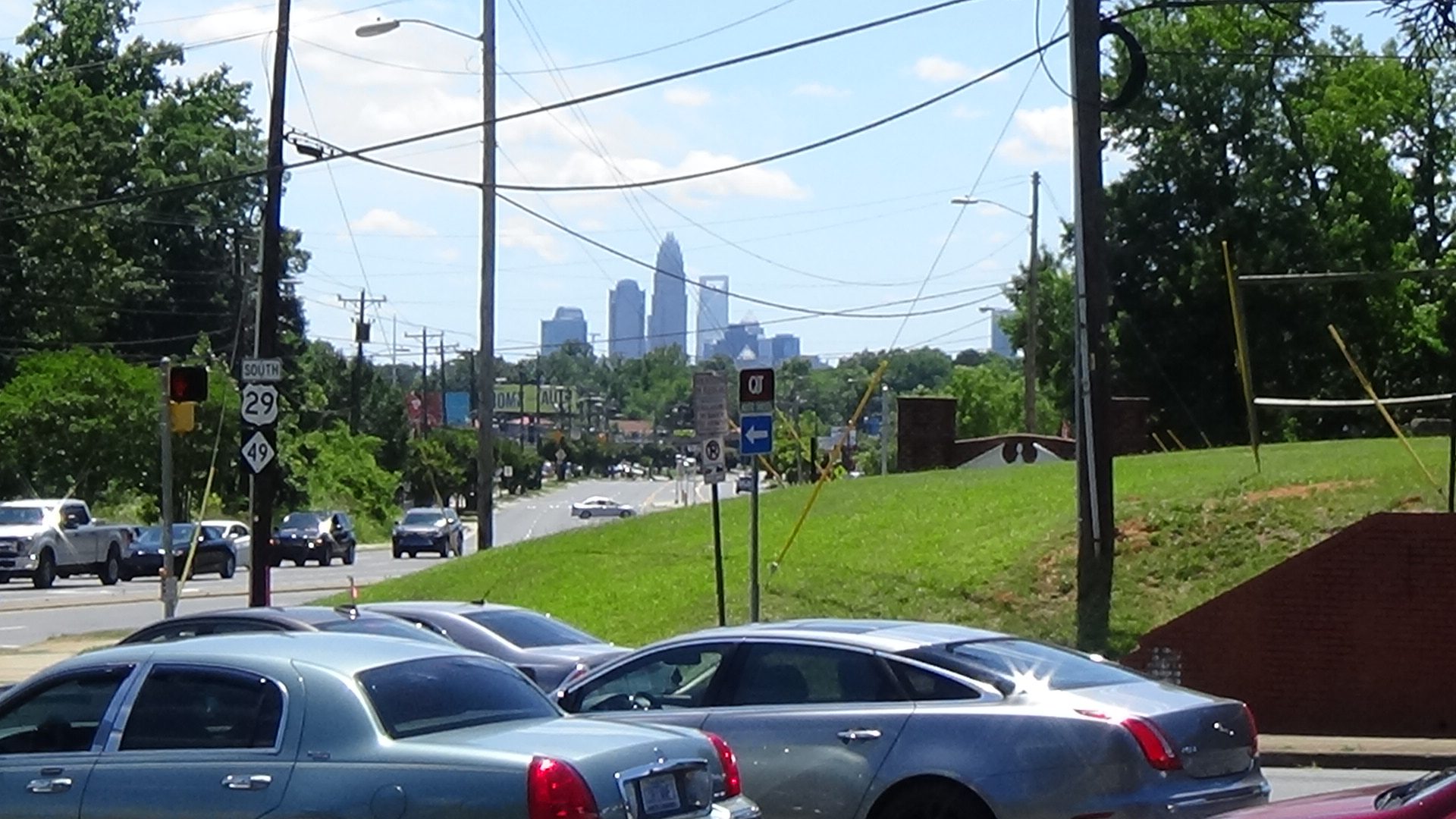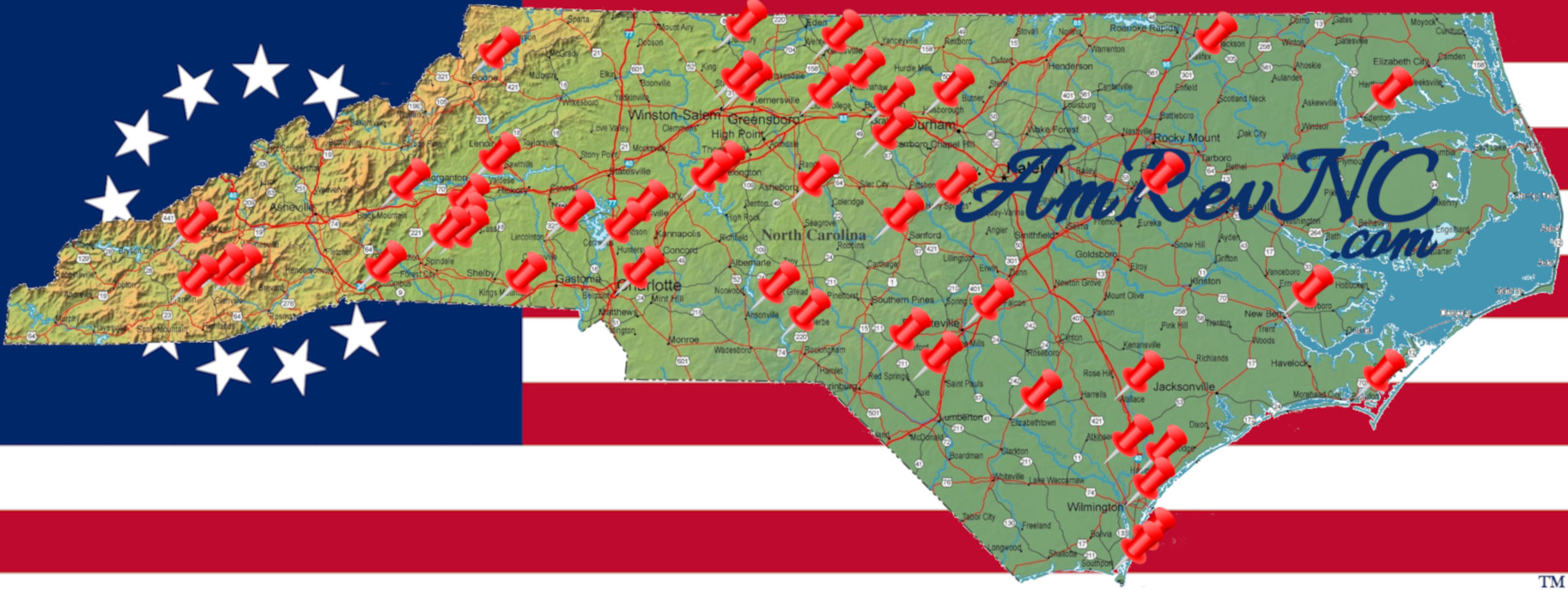Left for Dead, A Patriot Escapes
Location
Other maps: Bing, Google, MapQuest.
Coordinates: 35.2588, -80.7946.
Type: Stop
Tour: Race to the Dan
County: Mecklenburg
From the unpaved parking area of the Sugaw Creek Church cemetery, you can see the general vicinity of the action described below. To get a better view of the skirmish area, or see the memorial to Joseph Graham, take the sidewalk down Sugar Creek Road to the intersection with North Tryon Street.
Description

 Patriot part-time “militia” soldiers were pushed from Charlotte by the British on Tuesday, September 26, 1780. The militia headed toward the Continental Army in Salisbury, and the Redcoat infantry pursued them up the Salisbury Road (now North Tryon Street). After stopping at two creeks to the south to fire off volleys, two companies of militia re-formed in a line near the intersection with today’s Sugar Creek Road, along a ridgeline.
Patriot part-time “militia” soldiers were pushed from Charlotte by the British on Tuesday, September 26, 1780. The militia headed toward the Continental Army in Salisbury, and the Redcoat infantry pursued them up the Salisbury Road (now North Tryon Street). After stopping at two creeks to the south to fire off volleys, two companies of militia re-formed in a line near the intersection with today’s Sugar Creek Road, along a ridgeline.
That ridge is occupied now by the cemetery of Sugaw Creek Presbyterian Church, formed in 1755. At the time it was called “Sugar” Creek, an anglicized version of the original Catawba name to which the church changed in 1924.
The British infantry stopped well short, about 250 yards out. They took cover behind trees and fences and began to fire at will instead of in coordinated volleys.[1] This is unusual, which suggests the senior officer was under orders to avoid direct contact. The two sides exchanged fire from beyond the effective range of their weapons for about a half hour.
Then the Patriots learned the reason for the infantry action as Patriot stragglers passed through the crossroads and line. They found themselves pressed on two sides by British cavalry under Maj. George Hangar, totaling 350 green-coated men. They trotted up the hill along both today’s Tryon Street and from the left where Sugar Creek Road runs today, forcing the militia to fall back, knowing another Patriot position had been set three miles behind. The cavalry met at the intersection. Apparently some engaged the rear guard here while the rest turned north, breaking into a canter to pursue the militia.[2] The Redcoat infantry then pulled back to Charlotte while the cavalry continued the chase.

During the fight here, Patriot Capt. Joseph Graham ended up in a horseback sabre duel with one or more British dragoons. He was “badly wounded, with three bullet wounds in the thigh, a sabre thrust in his side, a gash on the neck, and four cuts to the forehead. He wrote of his head wound that, ‘some of my brains exuded.’”[3] British troopers found him after the battle somewhere in this vicinity, but decided not to bother killing him as he was clearly dying.
That was a mistake. After they left, he managed to crawl to a spring in the vicinity of the current church building across the street. He was found by Susannah Amanda Alexander, who took him to her family’s home nearby. She and her mother nursed him through the next day. A British officer’s wife offered to arrange a surgeon’s visit, but to avoid being captured, Graham somehow took off that night for his home in today’s Lincoln County.[4] He eventually returned to the army.
Susannah, married to Patriot soldier John Alexander, lived to 96 and is buried in the cemetery.
What to See
 A monument to Graham is on this side of Sugar Creek Road, facing it, near North Tryon Street. Dedicated in 1918 (not the date on the marker) it reads in part:
A monument to Graham is on this side of Sugar Creek Road, facing it, near North Tryon Street. Dedicated in 1918 (not the date on the marker) it reads in part:
Major Joseph Graham
Patriot, Soldier, Statesman
Received Nine Wounds In
Battle Of Charlotte
Was Left For Dead On
Sugaw Creek Road
September 26, 1780[5]
By continuing to the intersection, you can get a sense of the view the militia had of the British advance. The distant Uptown skyline makes clear how far the British continued their pursuit.[6]

Historical Tidbits
- The small building near the corner across the street was the Sugar Creek Academy. A 1771 wooden version was on or near the spot during the battle. A newspaper advertisement said in 1827, “Young men wishing to study Geography and Astronomy, can enjoy the benefits of a set of Globes.” Tuition was $20 a year. The current structure was built ten years later of bricks made by the schoolboys. An earthquake left cracks in 1866 still visible today.[7]
- Sugar Creek’s third pastor, “installed” in 1795, was the son of the famous Patriots Rev. David and Rachel Caldwell. He trained in his father’s academy next to their home in today’s Greensboro. Rev. Samuel Caldwell taught at the Sugar Creek Academy until his death in 1826.[8]
More Information
- Graham, William A. (William Alexander), General Joseph Graham and His Papers on North Carolina Revolutionary History (Raleigh, N.C.: Edwards & Broughton, 1904) <http://archive.org/details/cu31924032738233> [accessed 27 March 2020]
- Graves, Will, tran., ‘Pension Application of John Alexander, W20586’, 1846 <http://revwarapps.org/w20586.pdf> [accessed 22 August 2023]
- Lewis, J.D., ‘Charlotte’, The American Revolution in North Carolina, 2014 <https://www.carolana.com/NC/Revolution/revolution_charlotte.html> [accessed 24 December 2019]
- MacLeod, Mrs. John Blount et al., Seventy-Five Years of Service: History of the National Society Daughters of American Revolution of North Carolina (New Bern, NC: Owen G. Dunn Co., 1975)
- ‘Major Joseph Graham, Charlotte’, Commemorative Landscapes of North Carolina, 2010 <https://docsouth.unc.edu/commland/monument/887/> [accessed 17 June 2020]
- McGeachy, Neill Roderick, A History of the Sugaw Creek Presbyterian Church, Mecklenburg Presbytery, Charlotte, North Carolina (Rock Hill, S.C. : Printed by Record Print Co., 1954) <http://archive.org/details/historyofsugawcr00mcge> [accessed 9 May 2020]
- ‘Susannah Alexander (Wilson) (1760-1856)’, GENi <https://www.geni.com/people/Susannah-Alexander/6000000021467443902> [accessed 22 August 2023]
- ‘Susannah Wilson Alexander (1759-1856)’, Find a Grave Memorial <https://www.findagrave.com/memorial/42332887/susannah-alexander> [accessed 22 August 2023]
[1] Graham 1904.
[2] Ibid.
[3] Lewis 2014.
[4] McGeachy 1954.
[5] ‘Major Joseph Graham, Charlotte.’
[6] In addition to the other listed sources, “Stop” information comes from one of two guidebooks; NCpedia; the online essay for the relevant North Carolina Highway Marker; and related Sight pages (see “About Sources“).
[7] Quote from McGeachy; MacLeod 1975.
[8] McGeachy.



